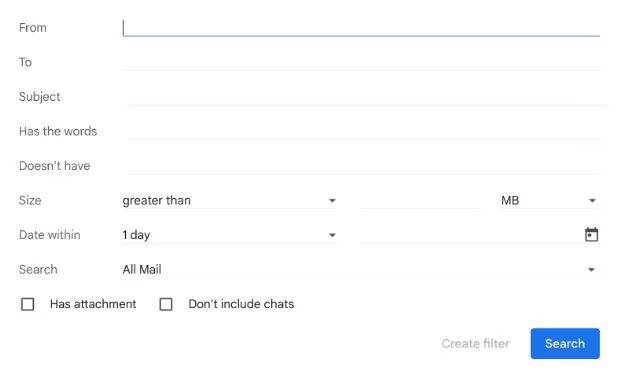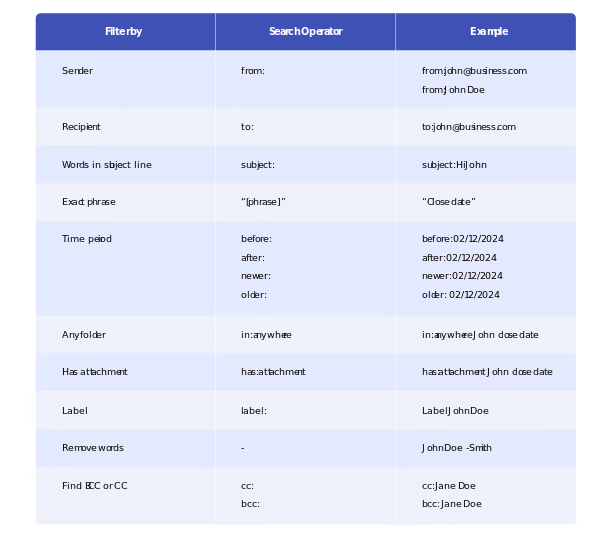How to organize your Gmail inbox
8 efficient strategies to declutter your Gmail inbox. Learn how to categorize, archive, and manage emails to boost your productivity and streamline your digital communication.
If your inbox is too messy to effectively find past emails quickly, then congratulations! You’re just like everyone else.
However, this turns into a real issue if you’re on the hunt for an all-important email from the past — such as a business communication or a tax document.
You’ve likely used Gmail’s search function in the past, but odds are, you’re only using it to a fraction of its potential. That’s why every user should have a basic understanding of Gmail search operators.
<a href="#what-are" class="anchor-link">What are Gmail search operators?</a>
<a href="#who-uses" class="anchor-link">Who uses Gmail search operators and why?</a>
<a href="#how-to-search" class="anchor-link">How to search your Gmail inbox</a>
<a href="#how-to-use" class="anchor-link">How to use the most common Gmail search operators</a>
<a href="#common-gmail" class="anchor-link">Common Gmail search operator examples</a>
<a href="#find-emails" class="anchor-link">Find emails quickly without search operators</a>
<div class="anchor-wrapper"><div id="what-are" class="anchor-target"></div></div>
Gmail search operators are symbols and words that you can use to find exactly what you’re looking for within your Gmail inbox. By using these commands, you can find the specific email (or group of emails) you’re trying to track down.
You can filter by:
That’s just to start. With dozens of available Gmail search operators, you’ll quickly be able to find what you’re looking for.
<div class="anchor-wrapper"><div id="who-uses" class="anchor-target"></div></div>
Rather than search one by one through your email, Gmail search operators allow you to quickly sift through messages and show only the ones you’re looking for.
Many businesses love the personal touch, convenience, and deliverability of using Gmail. However, organizing communication with a couple dozen clients quickly gets out of hand. With the right search operators, you can pull up the right group of emails to have on hand for your reference.
They’re also handy for anyone who wants to find a personal email from a friend or a spreadsheet about assignments for a family reunion.
In other words, every Gmail user could benefit from using search operators. Even having a few go-to ones can save you time and headaches.
<div class="anchor-wrapper"><div id="how-to-search" class="anchor-target"></div></div>
You’ve probably seen this in your Gmail inbox before:

The Gmail Search Box is the simplest version of Gmail’s search function, and it’s possible you’ve been frustrated by the broad results it returns for you.
However, there’s a simple way to create an advanced search to help improve your filtering. First, go ahead and click on the filter icon to the far right of the search bar:

You’ll then see this dropdown feature:

Here, you’ll see a whole host of ways to filter your searches, such as inputting:
For many people, using these search functions is a great start. However, adding a few of the most common search operators to your repertoire can help improve your ability to find the right email.
<div class="anchor-wrapper"><div id="how-to-use" class="anchor-target"></div></div>
All you have to do is type these Gmail search operators right into the search bar:

In addition, if you simply put your cursor in the search box, Gmail gives you built-in search “chips.” In this example below, you can click on “Has attachment,” and it’s as if you’ve used the operator “has:attachment.”

Google’s documentation lists around 30 search operators that can be used in its email platform.
<div class="anchor-wrapper"><div id="multiple-search" class="anchor-target"></div></div>
You can also improve your filtering by combining search operators to narrow down the results.
For example, let’s say that you’re looking for an email that one of your clients, John Doe, sent you. You know that the email had an important attachment in it.
You could type this into the search bar:
from:John Doe has:attachment
This search operator would help you locate anything from John with an attachment almost immediately.
<div class="anchor-wrapper"><div id="gmail-search" class="anchor-target"></div></div>
Gmail’s search operators are fully functional from mobile devices as well. Simply use any of the search operators, and you’ll instantly get the results you need.

In addition, when you tap the search bar, you’ll see tappable chips with these titles:
Again, when you click on one of those options, it’s as if you’re using the actual search operator for that filter.
<div class="anchor-wrapper"><div id="troubleshooting" class="anchor-target"></div></div>
If your searches are producing broad results or nothing at all, then there are a couple of things that you can try:
<div class="anchor-wrapper"><div id="common-gmail" class="anchor-target"></div></div>
Here are a few common ways of using search operators to find specific emails in your Gmail inbox.
<div class="anchor-wrapper"><div id="find-specific" class="anchor-target"></div></div>
🔍 From:john.doe@acme.co
In the search box, go ahead and type in “from:” and then either put in their name or their email address. If you want to find all emails from your cousin John, you could type in “from:john@gmail.com,” inserting whatever his real email address is.
<div class="anchor-wrapper"><div id="find-labeled" class="anchor-target"></div></div>
🔍 Label:John Doe
Many users like to manually or automatically label emails from certain senders. For example, a business might want to organize every email sent from a client named John Doe, and you create a label with his name. Later, you can search these labels with “label:John Doe.”
<div class="anchor-wrapper"><div id="find-unread" class="anchor-target"></div></div>
🔍 Is:unread
Many of the more organized users like to have all emails marked as “read” or they feel like they have unfinished business. To search for these, type in “is:unread.”
<div class="anchor-wrapper"><div id="exclude-words" class="anchor-target"></div></div>
🔍 John Doe -Smith
Perhaps you have two different clients named John, and a broad search (even using last names) pulls up all communications with both. Your solution would be to search for “John Doe -Smith.” This would bring up all communication with John Doe, while excluding John Smith’s messages.
<div class="anchor-wrapper"><div id="find-emails" class="anchor-target"></div></div>
Rather than using Gmail’s search operators and filters to manage your client relationships, try using Streak pipelines.
Streak integrates directly with Gmail, helping you and your team seamlessly track every interaction you have with your contacts. When it’s time for your next call, just look up the associated deal or contact to review previous interactions, find attachments, and prepare for a productive conversation.
Where others use complicated filtering and copy-pasting emails into spreadsheets, you can spend your time where it matters: on building relationships.
With our flexible pricing plans, Chrome extension, and built-in automations, you’ll find yourself more effective than ever before. In fact, go ahead and give us a try for free to see how easy it is to streamline your sales process.
